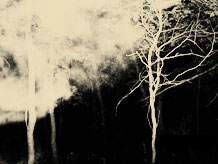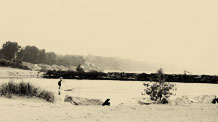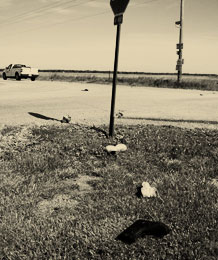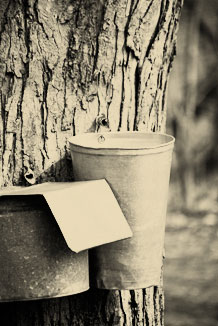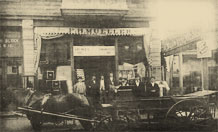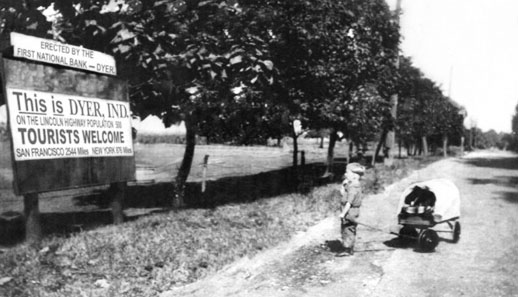
Anita Kahler, Lincoln Highway circa 1920 [photo by Dyer Historical Society]

Dyer emerged from wetlands to become a thriving suburb
September 22, 2010
Like many towns in Northwest Indiana, the town of Dyer’s beginnings are rooted in the geological history of the area.
Dyer resides on an old shore of Lake Michigan. An ancient shallow sea once covered the land, and limestone was formed from the sediment the sea left behind. Glaciers carved their way through the area, fashioning a bowl-like feature into the limestone. When the ice sheets melted at the end of the last Ice Age, this “stone bowl” became a depository for the water that formed the Great Lakes.
As Lake Michigan receded, it left behind shallow swamps and a high ridge of sand dunes that attracted animals. Their migration there created a pathway through the wetlands, which the Native Americans used. The pathway became known as the Sauk Trail, which existed under many flags.
French fur trappers known as voyageurs were the first Europeans to inhabit the area. After the French and Indian War, the British owned the land. Spaniards even laid claim to the area, though for only a day. It didn’t become part of the United States until after the War of 1812. The Potawatomi tribe under Chief Pokagon traversed the old Sauk Trail for the last time in 1873.
A hotel and a saloon were the first permanent buildings to contribute to Dyer's framework. The businesses were built in 1838 to accommodate travelers making their way east and west through the region.
The purchase of 17,000 acres of swampland in 1857 proved to be seminal to the town's development. Aaron Norton Hart bought the land with his wife, Martha Dyer Hart, and dug a system of ditches. He straightened Plum Creek, also known as Hart's Ditch, to drain the water from the property, and fertile soil ideal for farming remained. Aaron Hart met his end, however, when a wall of Hart’s Ditch fell on him during maintenance work.
People, particularly German Catholic immigrants, flowed into the area for the farmland, spurring the formation of railroads, a grain elevator and many businesses. Dyer's formal christening as a town came after a vote in 1910. Comprising the town’s foundation at the time were three hotels, blacksmiths, general and dry good stores, a meat market, bank, a funeral home, a pickle and sauerkraut factory, a creamery, a cigar factory and numerous saloons.
A stretch of the old Sauk Trail running through Dyer and Schererville succumbed to modern needs as the Lincoln Highway pulled into town, the nation's first transcontinental highway. The roadwork transformed a portion of the trail into what became known as Lincoln Highway's Ideal Section: four paved lanes that boasted street lamps and decor. The road earned Dyer a spot on the map when it was completed in 1921 and opened to great fanfare. People came from miles around to drive the two-mile stretch at night with their car lights off.
Lincoln Highway stretched from Times Square in New York City to land's end in San Francisco. It became known as U.S. 30 when the U.S. Bureau of Public Roads began using a numerical naming system for trails and roads in 1925.
Planned subdivisions began to dot the rural landscape after World War II, as people emigrated from cities. Dyer’s population grew, as did the traffic, which compelled officials in the early 1990s to raze the old business district so U.S. 30 could be widened.
An archive of the town’s history got its start when Glen Eberly, a member of Dyer’s Town Board, set up a display of town artifacts during a celebration of the nation’s bicentennial in 1976. It grew into a large collection that currently is housed in the Glen Eberly Museum in the lower level of Dyer Town Hall and maintained by the Dyer Historical Society.
The museum offers artifacts, video recordings of members of older generations who once resided in Dyer, the genealogical history of numerous families and old photographs.
It is open to the public from 9:30 a.m. to 2:30 p.m. weekdays or by appointment. For more information about the history of Dyer, the Glen Eberly Museum and the Dyer Historical Society, visit the town’s website at http://www.townofdyer.com.



